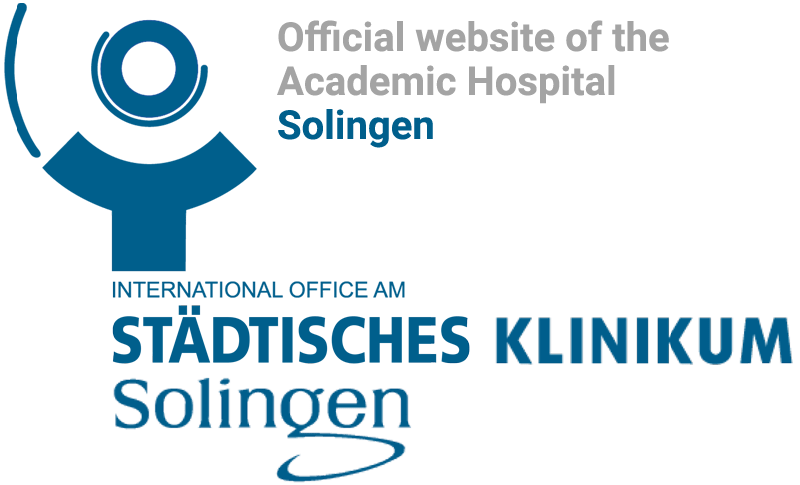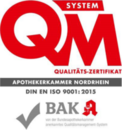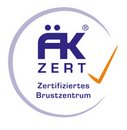Spectrum of Services
Our Concept
We, the staff of the Clinic of Gastroenterology, Oncology and General Internal Medicine made an ideal model of our clinic that reflects the motives and foundations of our activity,
describes our goals, and also introduces our employees to you.
We are aware that it will not be easy to achieve jointly developed goals. Therefore, we believe that on our way to this goal we need the basic principles that will serve as a guide and scale for our actions. We consider the process
of approaching our conception as a development process in which our model, thanks to concrete actions and fantasies, will be filled with life and will develop further.
We are a universally recognized interregional Clinic of Internal Medicine with specialization in the field of gastrointestinal diseases and metabolic disorders at the City Clinical Hospital in Solingen.
Non-profit limited liability company the City Clinical Hospital of Solingen is a full medical care hospital and includes 15 clinics and institutes. The shareholder is the city of Solingen.
The clinic is an academic hospital in Cologne University. It is located in the city center in the botanical garden area and has good transport links. We combine advanced methods of treatment with an individual approachWe offer comprehensive,
advanced diagnostics and treatment in good atmosphere. At the same time, the focus of our attention is on the needs of each patient. All our employees work as one team, relying on solid medical knowledge and new discoveries. For
the sake of the good of our patients, we work closely with all departments both inside the clinic and outside it. Modern equipped rooms provide everyone a comfortable stay in the clinic.
Strengthening health and alleviating suffering in atmosphere of mutual tolerance and respect.
It is very important for us to promote physical and mental health. We respect the personality and self-determination of each patient. Human warmth when communicating with the patient creates an atmosphere of trust. We constantly
inform our patients in an accessible form and accompany them throughout the treatment process.
We support the independence of all employees of our team. Open and confidential communication is for us a matter of course. In our organizational structure, we attach great importance to the transparency and clarity of decision-making,
we flexibly react to new developments and are always open to them. Therefore, we always promote the development of skills and retraining of all our employees and expect them to be ready for further training.
We work with the mind, heart and hands.
Our clinic is divided into separate groups for the care of patients, in which we work as one team. Our patients are looked after around the clock by people they trust. We treat each other politely, openly and friendly.
To ensure high quality of work, we rely on scientifically based recommendations of recommendatory nature. The quality of our work is constantly documented and verified. We jointly discuss all decisions and try to justify them. They
are mandatory for all, and the implementation of these decisions is constantly monitored.
Hematology
Along with classical chemotherapy, we offer individual treatment programs, such as antibody therapy, immunomodulators and “targeted” therapy.
Treatment can be performed outpatiently as well as inpatiently. In addition, we have the conditions for the transplantation of stem cells during the use of high-dose chemotherapy. For us, detailed, detailed consultation of the patient
and an individual approach are important.
Dr. Viola Fox
Dr. Viola Fox is a highly experienced and accomplished doctor specializing in internal medicine, hematology, and oncology. With an impressive 22 years of experience, she has established herself as a leader in her field. Dr. Fox currently is the head of the Department of Oncology at the academic hospital Solingen, Germany.
With her vast experience, numerous publications, and focus on personalized medicine, Dr. Fox is highly regarded for his contributions to hematology, oncology, and leukemia research. Her expertise and dedication to advancing personalized medicine make her an exceptional doctor, benefiting patients in Germany and beyond.Overall, Dr. med. Viola Fox is a highly respected and skilled doctor in the field of hematology and oncology. Her wealth of experience, commitment to research, and dedication to patient care make her a top choice for individuals seeking specialized treatment in Germany.
How to contact a Doctor?
If you would like a consultation or a second opinion from Dr. Viola Fox, to diagnose and treat your diagnosis, please contact our international specialists, write to us or leave a request for a call back.
Email: kontakt@international-office-solingen.de
Tel: +49 212 5476913
Viber | WhatsApp | Telegram:
+49 173-2034066 | +49 177-5404270
Ftunctional Diagnostics
Gastroenterological functional diagnostics includes various methods of research, with the help of which functional disorders of the esophagus, stomach, small and large
intestine are examined. In this case, the spectrum of individual procedures, as a rule, is not widely described.
MEDICAL PROFILE
- Esophagomanometry
Functional disorders of the esophagus are usually characterized by a feeling of food stuck (dysphagia) during swallowing or pain in the thoracic region, not caused by heart or lung diseases. In such patients, the pressure of the musculature of the esophagus and the upper and lower sphincters during the swallowing act is measured for the diagnostics using manometry. Typically, manometry is used before surgery on the lower sphincter of the esophagus. For examination, the measuring probe is inserted through the nose into the esophagus. Thus, the study compared with gastroscopy is much less unpleasant and can be performed by patients who are conscious. - Anal sphincter manometry
Measurement of the anal sphincter pressure can be administered to patients with a functional disruption of the sphincter of the anus or when certain operations on the large intestine are necessary. - pH-metry
Measurement of acidity in the esophagus and in the stomach is necessary, for example, in patients with gastroesophageal reflux. In addition, such examination can be conducted for patients with complaints, despite the medication being received. For pH-metry, a flexible probe with a pencil thickness is inserted through the nose into the esophagus and left there for 24 hours. The study can also be conducted on an outpatient basis, while patients can eat and drink.
Under certain conditions, some patients get measurement for 96 hours. In such cases, a small capsule is implanted under the control of endoscopy in the lower part of the esophagus (Bravo capsule). The measurement data are transferred to a recording device located on the patient’s body. The capsule detaches itself from the esophagus after a few days and is excreted along with the feces. - Respiratory tests
Oral glucose tolerance test (OGTT)In some of our patients who have turned to our clinic for non-specific digestive disorders, we do not get results explaining these disorders when conducting standard methods of investigation, such as ultrasound examination or colonoscopy. If there are additional signs indicating intolerance to certain food, you can perform respiratory tests to determine if lactose or fructose is intolerant. In isolated cases with the help of a breath test can detect the pathological colonization of the small intestine by bacteria.
Depending on the type of test, the patient should, after a certain time, exhale into a tube after taking milk sugar (lactose), fruit sugar (fructose) or sugar (glucose). In the exhaled air, the hydrogen content is measured. - OGTT serves to determine or exclude diabetes mellitus.
In this case, after determining the concentration of blood glucose on an empty stomach, 200 ml of water is diluted with 75 g of glucose dissolved in it and after two hours, glucose in the blood is again determined. At a rate of ≥ 200 mg/100 ml, there is diabetes mellitus.
In this case, a combined treatment is required, often with the patient’s compliance with a new lifestyle (weight loss, increased mobility, etc.), diets and, if necessary, medication intake. - Iron absorption test
When the iron absorption test is performed, the ability of the small intestine to sufficiently absorb iron obtained with food is examined. This test is worthwhile in those cases when an insufficient level of iron in the blood is detected and the possible reason for this is a disorder of the assimilation of iron in the intestine. Most often, iron deficiency is a consequence of loss of blood. In practical terms, the test is conducted as follows: after a 12-hour fasting period, blood is taken to determine the level of iron on an empty stomach. After this, the patient needs to take 200 mg of iron in a tablet form, with a sip of water. Accordingly, after 2 and 4 hours, a second blood sample is taken. If there is a low level of iron in the blood and when taking the iron preparation there is a significant increase, then in this case it is a significant insufficiency, but the intestinal absorption index is not impaired. If the increase in the concentration of iron does not occur, then there is a violation of absorption of the iron and the cause is determined. - Video capsule endoscopy (VCE)
When carrying out this method, a device consisting of a light source, a video camera and a transmitter, in shape and size corresponding to the capsule with the medicine, is swallowed by drinking water. Before this, 8 flat antennas on the abdomen are glued in a certain position, similar to the way that many patients who got Holter monitoring ECG are aware.
The camera transmits for 10 to 12 hours of high-resolution photos of the gastrointestinal tract to a portable recording device. After you return the device from these images, you can compose a video. The capsule is an expensive disposable device, which after isolation in a few days is naturally released into the garbage after the test. In addition, the battery is discharged.
This method is suitable only for assessing the mucosa of the small intestine, especially if there is a suspicion of bleeding in this localization. It cannot be a substitute for cancer screening in the form of colonoscopy (endoscopy of the large intestine) or gastroscopy.
Port-System for conducting Chemotherapy
In the process of treatment, many oncological patients receive medications in the form of intravenous infusion. First, such a system is necessary for chemotherapy – most cytotoxic drugs cannot be taken in the form of tablets. However, the creation of new venous accesses each time causes pain, the risk of inflammation increases in proportion to the duration of treatment, and in addition, there is a certain risk that cytotoxic drugs will accidentally fall into the surrounding tissues rather than the vein.
Therefore, patients often have implanted the so-called port-system under the skin: a small reservoir with a catheter that enters a vein located close to the heart. With the help of a special needle, doctors can inject cytotoxic medications
through the port without having to search for a suitable vein each time. After the port-system has taken root, it does not interfere with the patient and does not limit its freedom of movement.
What is a port system? What happens to the port after the treatment is completed? How should you care for the port system and how long can it stay in the patient’s body?
Port system is a small reservoir of metal or polymer material. It implants under the skin and connects to the vein.
In order to facilitate such long-term treatment as chemotherapy, a so-called port is often implanted under the skin for a patient: a small reservoir of metal or polymeric material with a membrane and catheter that enters a vein close to the heart. This port system is mainly installed in the area just below the collarbone. For such a small intervention, local anesthesia is sufficient. Depending on the situation, it can be supplemented by a slight superficial anesthesia.
In principle, the system can be used immediately. However, in most cases, doctors prefer to wait until the port heals, which occurs within a few days. Thus, it can be avoided that cytotoxic drugs or other medications interfere with the healing process.
What are the advantages of the port system? What is the port system for?
Doctors can inject medications through the port, which otherwise patients receive as an infusion or injection into a vein of the hand or palm. Chemotherapy drugs irritate the blood vessels in the area of the injection site, which
often leads to inflammation of the veins. Therefore, the use of the port system during chemotherapy has its advantages: The catheter enters a larger vein close to the heart, and here drugs are quickly distributed due to a stronger
current of blood. Thus, the walls of venous vessels are preserved. The danger that the infusion accidentally gets into the tissues in the form of the so-called paravasat in case of using the port is also significantly lower than
when accessing through the vein of the hand: in this case, it is practically impossible to “miss the vein”, which avoids inflammation and destruction of tissues.
In addition, the following should be added here: not only cytotoxic drugs, but also other medications, for example many pain relievers, can be injected through the port system. In patients with poorly accessible veins, doctors often
take blood for analysis also through the port. Patients who need parenteral nutrition, that is, in artificial feeding through infusions, can also receive it through the port system. Since the port system is completely located under
the skin, then, in agreement with the attending doctor, patients with the port in most cases can easily take a bath, shower or even exercise.
Flushing: care of the port-system in the intervals between the courses of treatment
Observance of the general rules of hygiene when using the port system is just as important as with all other types of injections or infusions. In addition, in order to remain functional, the port system needs some care, including,
and in breaks between treatment courses.
Port-System Passport
In many clinics, it is accepted, that the doctor who installed the port issues a passport of the port-system to the patient. The patient can find instructions regarding his model of the port-system in it. Patients who have a passport
of the port-system should, if possible, always have it with them, and bring with them to control examinations. Especially important is this information when changing a doctor or in case of emergency.
How often do I need to clean the port-system? Flushing the port-system
How and how often it is necessary to flush the port-system patients should discuss with their attending physician. After each drug administration through the port, and always after taking blood through it, the port must be flushed.
Due to this, it is possible to prevent the formation of blood clots (thrombi) in the catheter system. They can clog not only the port, but also the appropriate veins. Symptoms of such thrombosis are swelling and inflammation.
Is it necessary to flush the port-system and in those cases if it is not used for the foreseeable future? There is no unified research data on this issue so far. In the question of how and how often to flush the port, clinics rely
on their previous experience, as well as recommendations of the manufacturers of the port-system.
Some experts believe that there is no need to flush the system at the end of the treatment itself. Some manufacturers recommend rinsing the port every 4-6 weeks. However, many patients are called to flush the port only every three
months, and in some clinics even less often. Since the recommendations for individual models of the port-systems are also different from each other, patients should discuss with their physicians the need and dates of regular flushing.
Flushing with heparin or saline solution? What is heparin?
Heparin is a natural substance that inhibits blood clotting. As a medication, heparin prevents the formation of blood clots, for example in the catheter of the port-system. For flushing the system, doctors often use heparin solution.
Heparin is naturally produced in the body and participates in the process of blood clotting. As flushing solution, heparin prevents the formation of blood clots in the veins and in the catheter of the port-system. However, in some
patients, heparin can cause severe side effects, for example heparin-induced thrombocytopenia (HIT-heparin-induced thrombocytopenia), a decrease in the number of blood platelets that can lead to agglutination of blood platelets (platelets)
and subsequently to blood clots or bleeding.
Due to these rare but severe side effects, many clinics have already refused to flush the port with heparin. Instead, doctors flush their patients’ ports with saline, the salt content of which is similar to that of the salt in the
blood. To date, there are few studies that would explore the advantages and disadvantages of both methods. Existing studies do not show any significant differences between flushing with heparin or saline.
Installation time: How long can the port system remain in the patient’s body?
Patients should discuss with their attending doctors how soon after the end of treatment the port system can be removed.
One port withstands from about 1,500 to 2,000 injections of a specially designed needle. While this resource of the port system is not exhausted, it can remain in the patient’s body as long as necessary, provided that it is properly
maintained – even after the end of therapy. It is important that the port does not become inflamed: with infections, it must be removed, as otherwise there is a risk of infection of the blood (sepsis). Other reasons for premature
removal of the port may be its displacement, leakage or prolonged blockage of the catheter or “thrombosis of the port system.”
Many doctors recommend that patients leave the port system in the body for another two or three years after the end of therapy. During this time, the risk of recurrence is highest for many cancers. If patients once again require
chemotherapy or other medication, the old port is immediately ready for use. Due to this, patients will not need new interventions to remove the old and install a new port. In addition, the existing venous access can be used, for
example, for analgesic therapy or for the introduction of so-called parenteral nutrition by infusion of the solution.
How is the port system removed?
If, at the conclusion of therapy, patients no longer need a port system, it can be removed after consultation with the attending doctor about all the advantages and disadvantages. In the event that later, after all, there will be
a need for repeated chemotherapy, it is possible to install a new port-system. However, as a rule, it cannot be implanted in the same place. In most cases, the catheter is placed in another vein close to the heart of a fairly large
size.
To remove the port-system again, a small surgical intervention is necessary. As a rule, it is performed on an outpatient basis. In general, patients receive local anesthesia. Sometimes general anesthesia is required, especially in
cases of painful inflammation or extensive scarring around the port. If possible, when removing the port-system, surgeons perform a cut in the area already having a postoperative scar. Due to this, the second scar does not appear.
As with the implantation of the port, after the intervention, patients may suffer from wound pain in the area of the operation. However, they are amenable to treatment with medications.











